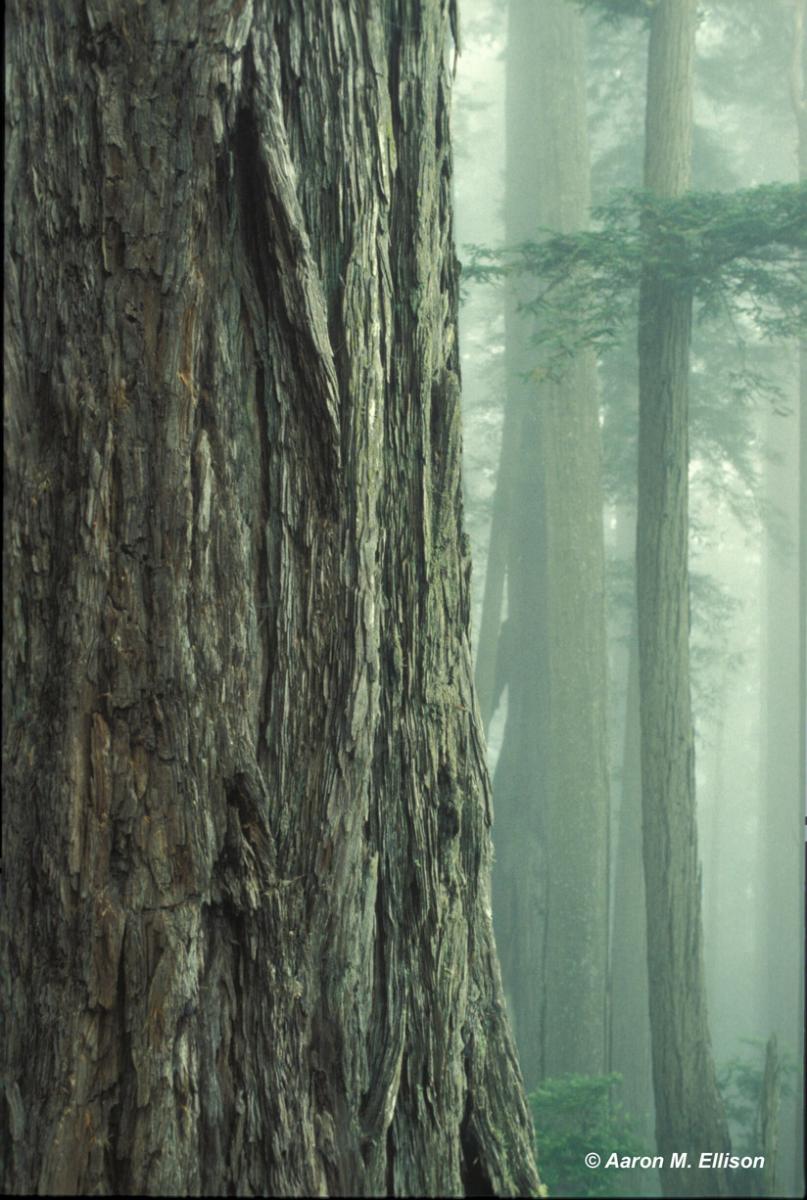You are here
Foundation species in forests
 In many forested ecosystems, the architecture and functional ecology of certain tree species define forest structure and their species-specific traits control ecosystem dynamics (see Ellison et al. 2005 for a review and summary of the conceptual ideas underlying this research thrust). Such foundation tree species are declining throughout the world due to introductions and outbreaks of pests and pathogens, selective removal of individual taxa, and over-harvesting. The ongoing decline of many foundation species provides a set of important, albeit unfortunate, opportunities to develop the research tools, models, and metrics needed to identify foundation species, anticipate the cascade of immediate, short- and long-term changes in ecosystem structure and function that will follow from their loss, and provide options for remedial conservation and management. A large-scale, long-term experiment on the loss of a foundation species was initiated in 2003 at the Harvard Forest Long-Term Ecological Research site. This experiment - the Hemlock Removal Experiment - examines the response of a late-successional forest ecosystem to the removal of its foundation species - Eastern hemlock (Tsuga canadensis). Throughout the eastern United States, hemlock is declining as it is killed by an exotic, invasive insect, the hemlock woolly adelgid (Adelges tsugae). In many areas, human activities are contributing substantially to this decline, directly through pre-emptive salvage logging, and indirectly through continued inaction to prevent regional climate change (warming) which will favor the expansion of the adelgid. The Hemlock Removal Experiment includes replicate 90 x 90 m hardwood and hemlock control treatment plots; replicate 90 x 90 m commercial preemptive salvage logging plots; and replicate 90 x 90 m plots in which all hemlocks were girdled in 2005 to kill them in place, simulating the slow death by the adelgid. Response variables include environmental variables (currently air and soil temperature, and light levels); population and community dynamics of seeds, seedlings, understory and overstory vegetation, arthropods, and salamanders; and carbon and nitrogen cycling; Two years of data were collected prior to the imposition of treatments in 2005. If you would like to measure additional response variables and you want to participate in this project, please see the Guidelines for Conducting Research at the Harvard Forest.
In many forested ecosystems, the architecture and functional ecology of certain tree species define forest structure and their species-specific traits control ecosystem dynamics (see Ellison et al. 2005 for a review and summary of the conceptual ideas underlying this research thrust). Such foundation tree species are declining throughout the world due to introductions and outbreaks of pests and pathogens, selective removal of individual taxa, and over-harvesting. The ongoing decline of many foundation species provides a set of important, albeit unfortunate, opportunities to develop the research tools, models, and metrics needed to identify foundation species, anticipate the cascade of immediate, short- and long-term changes in ecosystem structure and function that will follow from their loss, and provide options for remedial conservation and management. A large-scale, long-term experiment on the loss of a foundation species was initiated in 2003 at the Harvard Forest Long-Term Ecological Research site. This experiment - the Hemlock Removal Experiment - examines the response of a late-successional forest ecosystem to the removal of its foundation species - Eastern hemlock (Tsuga canadensis). Throughout the eastern United States, hemlock is declining as it is killed by an exotic, invasive insect, the hemlock woolly adelgid (Adelges tsugae). In many areas, human activities are contributing substantially to this decline, directly through pre-emptive salvage logging, and indirectly through continued inaction to prevent regional climate change (warming) which will favor the expansion of the adelgid. The Hemlock Removal Experiment includes replicate 90 x 90 m hardwood and hemlock control treatment plots; replicate 90 x 90 m commercial preemptive salvage logging plots; and replicate 90 x 90 m plots in which all hemlocks were girdled in 2005 to kill them in place, simulating the slow death by the adelgid. Response variables include environmental variables (currently air and soil temperature, and light levels); population and community dynamics of seeds, seedlings, understory and overstory vegetation, arthropods, and salamanders; and carbon and nitrogen cycling; Two years of data were collected prior to the imposition of treatments in 2005. If you would like to measure additional response variables and you want to participate in this project, please see the Guidelines for Conducting Research at the Harvard Forest.
Parallel experiments on the loss of foundation species are being conducted at the Coweeta Hydrological Laboratory's Long-Term Ecological Research site (hemlock removal) and the Black Rock Experimental Forest (oak removal).
This project is a core experiment of the Harvard Forest Long-Term Ecological Research site supported by the U.S. National Science Foundation through grant 0620443. It is also a major focus of the Harvard Forest Summer Research Program in Forest Ecology, a Research Experience for Undergraduate (REU) site supported by the U.S. National Science Foundation through grant 0452254.

